Research Article
IMPLEMENTATION OF OUTCOME BASED EDUCATION FOCUSING ON CURRICULA, METHODOLOGIES AND OUTCOME
1115
Views & Citations115
Likes & Shares
The implementation of Outcome Based Education (OBE) has gained popularity in the last two-three decades across the globe. There is a need to maximize the learning capability using technology. Use of technology in education is a growing trend in India. OBE provides better teaching and learning environment. Unfortunately, there is not a single governing act or set of guidelines to implement the OBE in all respect. This research paper highlights the issues and challenges faced and handled during implementation of OBE in teaching-learning process for higher education. One of the principles, OBE adopted from American Accreditation Board of Engineering and Technology (ABET) is the learning outcome for each course that needs to be measured and used for continual quality improvement. In the late 80s-early 90s, the reforms in science and mathematics emphasized the need for analytical thinking in the curriculum. Opportunity to learn, think and implement in and out of class room is beyond the scope of traditional instructional task. Outcome based education (OBE) attempts to focus on the students learning. The learning outcome is a combination of knowledge, understanding-skill and attitude that a student needs to have a better life at work and community. The core of effective learning of educational system lies in the integration of three aspects: Curriculum redesigning based on data from student feedback, teaching-learning methodology by implementation of a blended process which includes teacher centric, learner centric and digital technology environment and assessment of students and Evaluation process which is implemented based on the analysis of previous students’ course outcomes.
In this paper we have discussed some of the conceptual, methodological and assessing challenges implemented at R V College of Engineering (RVCE) on the concept of opportunity-to-learn (OTL) through OBE.
OBE is not just a teacher or institution level process but a multistage process which when properly implemented at every level lead to an unbiased solid foundation for every kind of student for their career.
Keywords: Curriculum, Information and Communication Technologies (ICT), Achievable matrix, Course Outcome Attainment (COA).
The central focus of outcome-based education is learning (Spady, 1994). In the traditional teaching, improving the analytical thinking is beyond the scope of class room teaching. Collaborative learning helps in engaging the students in learning and developing their communication and team work skill. For engineering profession communication and collaborative skill is important (Cabrera, Villalon & Chavez, 2017). The reforms of science and mathematics emphasized the need for thinking and reasoning in the curriculum (Kisa & Stein, 2015). Usage of technology can make teaching and learning processes more efficient and productive (Schwalbe, 1996). In outcome-based education the focus is on learning outcome, so it is necessary to know the factors on which learning depends and the different types of improper learning. Learning is getting knowledge from inside to outside and also from outside to inside (Shulman, Taking Learning Seriously, 1999). Lee (Shulman, Taking Learning Seriously, 1999) pointed out that the pathologies involved in learning are malfunction of memory - amnesia, understanding - fantasia and application - inertia. Amnesia is the most common pathology, where the learners forget what they have learned or even do not remember that they have studied. Amnesia is not harmful as the learner does not remember but if the learner has a misconception of the previous learning then the new learning takes place based on the previous wrong conception. Fantasia is very dangerous, as it deals with misconception. In Inertia the idea is simply inert and sitting in the mind. It is not being used though the learner remembers. So, it is essential for the instructor to know the prior learning knowledge of the learner based on which the new concept can be explained. Educational psychologist Benjamin Bloom performed an experiment in 1950 to study inertia pathology. Bloom took two groups of students qualifying memory test. To both the group he asked an application-oriented question. In response to this 1st group responded that they have not studied as the question is application oriented and the 2nd group gave possible solution. Bloom concluded that both the groups remember very well the theory part but the 1st group lacks critical thinking and analysis. In 1956 Bloom gave “Taxonomy of Educational Objectives” to promote higher education based on analysis, evaluation, procedure and principles. The taxonomy of educational objective is based on three learning domains (Basril, Man, Badaruzzaman & Nor, 2004) i.e. cognitive mental skill (knowledge), affective: Growth in feeling or emotional areas (attitude) and psychomotor: manual or physical skill (skill). In the cognitive domain the skills are categorized into two groups. The lower order skills include remembering, understanding and applying, whereas the higher order skills deals with analysing, evaluating and creating. On successful completion of higher education, one must have attained these skills (Bellis, 2000; Erasmus & Van, 1999). In outcome-based education the focus of learning is based on the Bloom’s Taxonomy of Educational Objectives.
There are different learning approaches, which state that each individual has their own learning style. Kolb’s (1984) four learning styles are permutation of two dimensions: perception and processing. Felder and Silverman (1988) developed a learning style theory to be used for engineering education. This (Felder & Silverman, 1988) theory gives thirty-two learning styles, outcome of the permutation of five dimensions: Perception, input, organization, processing and understanding. The challenges in learning arise as learners come from a wide range of education background and diversity in their learning experience. To accommodate learners’ different learning style, collaborative learning and critical thinking ability are essential. The learning styles can be personalized in flipped learning (Szafir & Mutlu, 2013; Janz, Graetz & Kjorlien, 2012; Rutherfoord & Rutherfoord, 2013). OBE has adopted process of measuring the learning outcomes from American Accreditation Board of Engineering and Technology (ABET) (Jaafar et al., 2008). The main focus of the accreditation agencies is on better documentation of student learning outcomes (Wahab et al., 2011). But the challenge is, there are no well-defined steps to implement OBE for higher professional education. Information technology is being used in educational field to make it successful and interesting for teacher and student (Bhattacharjee & Deb, 2016).
OBE STRUCTURE
Every institute has its own vision and mission. Missions are steps through which institution vision can be achieved. Department/program vision and mission are derived from institute mission and vision. Each program has its own Program Specific Objective (PSO) and program outcomes (POs). Program Specific objectives are broad statements that describe the career and professional skills the students will be able to achieve under the program. The learning outcomes of a program are determined in terms of program outcomes. There are twelve graduate attributes known as Program Outcomes (POs) for all the engineering programs.
PO1-Engineering knowledge: Apply the knowledge of mathematics, science, engineering fundamentals, and an engineering specialization for the solution of complex engineering problems.
PO2-Problem analysis: Identify, formulate, research literature, and analyze complex engineering problems reaching substantiated conclusions using first principles of mathematics, natural sciences and engineering sciences.
PO3-Design/development of solutions: Design solutions for complex engineering problems and design system components or processes that meet the specified needs with appropriate consideration for public health and safety, and cultural, societal and environmental considerations.
PO4-Conduct investigations of complex problems: Use research-based knowledge and research methods including design of experiments, analysis and interpretation of data and synthesis of the information to provide valid conclusions.
PO5-Modern tool usage: Create, select and apply appropriate techniques, resources and modern engineering and IT tools, including modeling and prediction to complex engineering activities, with an understanding of the limitations.
PO6-The engineer and society: Apply reasoning informed by the contextual knowledge to assess Societal, health, safety, legal and cultural issues and the consequent responsibilities relevant to the professional engineering practice.
PO7-Environment and sustainability: Understand the impact of the professional engineering solutions in societal and environmental contexts and demonstrate the knowledge of and need for sustainable development.
PO8-Ethics: Apply ethical principles and commit to professional ethics and responsibilities and norms of the engineering practice.
PO9-Individual and team work: Function effectively as an individual, and as a member or leader in diverse teams, and in multidisciplinary settings.
PO10-Communication: Communicate effectively on complex engineering activities with the engineering community and with the society at large, such as, being able to comprehend and write effective reports and design documentation, make effective presentations and also give and receive clear instructions.
PO11-Project management and finance: Demonstrate knowledge and understanding of the engineering and management principles and apply these to one’s own work, as a member and leader in a team, to manage projects and in multidisciplinary environments.
PO12-Life-long learning: Recognize the need for and have the preparation and ability to engage in independent and life-long learning in the broadest context of technological change.
These are the expected program outcomes a student should have after successful completion of the program. There are several courses under each program to achieve the program outcomes. Each course under a program not necessarily contribute to all POs. Courses are linked to POs through course outcomes (COs), which are the learning outcomes of a course. Learning outcomes of a course is measured through CO attainment and similarly for a program, it is through PO attainment. Attainment of POs is done through course outcomes of all courses under the program. OBE is implemented in R V College of engineering. The learning outcomes are measured through CO/PO attainment. The success of OBE depends on the curriculum design, teaching - learning and assessment. How these aspects are adopted in order to improve the quality of education is discussed in this paper. However, the PO attainment discussion is beyond the scope of present paper. The relationship between different OBE terminology is shown schematically in Figure 1.
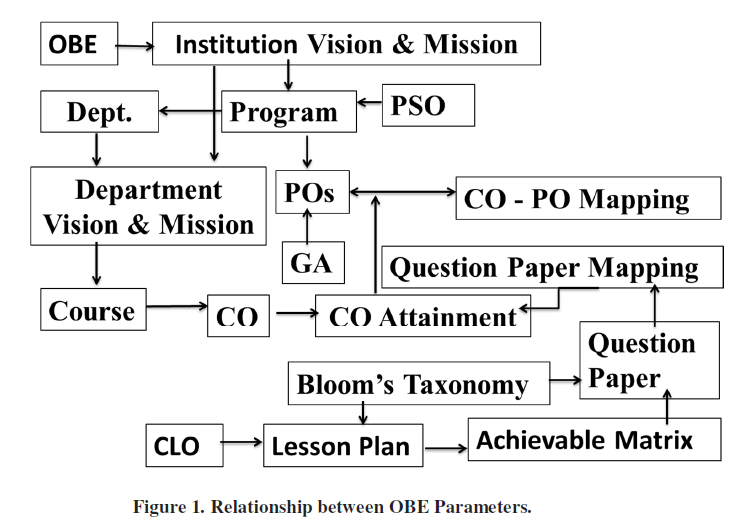

IMPLEMENTATION STRATEGIES
Step wise procedure for the implementation of OBE and measurement of learning outcomes.
STEP-1: CURRICULUM DESIGN
Curriculum is derived from the Latin word “currere”, which means “to run”. One of the objectives of a curriculum is to provide a template which will enable learning to take place. Curricula indicate the learning that is expected to take place from a course or programme of study in terms of knowledge, skills and attitudes. A syllabus describes the content of a course and can be seen as one part of a curriculum. Curriculum should specify the core teaching, learning and assessment methods. It also provides learning resources required for the course. A curriculum is more than a syllabus. The curriculum is designed and published as an official document. The aim of educational development is to ensure the implementation of official curriculum without any deviation. There are various studies dedicated to designing of curriculum in different educational fields (Gomes, et al., 2006), (Crosthwaite, Cameron, Lant & Litster, 2006).
Curriculum design must reflect need of student, industry, government and changing nature of society (Walkington, 2002). Educational institutes are challenged in designing and revising curriculum (Reichgelt, Zhang & Price, 2002). The designing of the curriculum is done meticulously considering the industry need, societal need, economic growth, employment as well as various other inputs. There is a process needs to be followed to prepare the curriculum. A sample curriculum design process is shown in Figure 2.
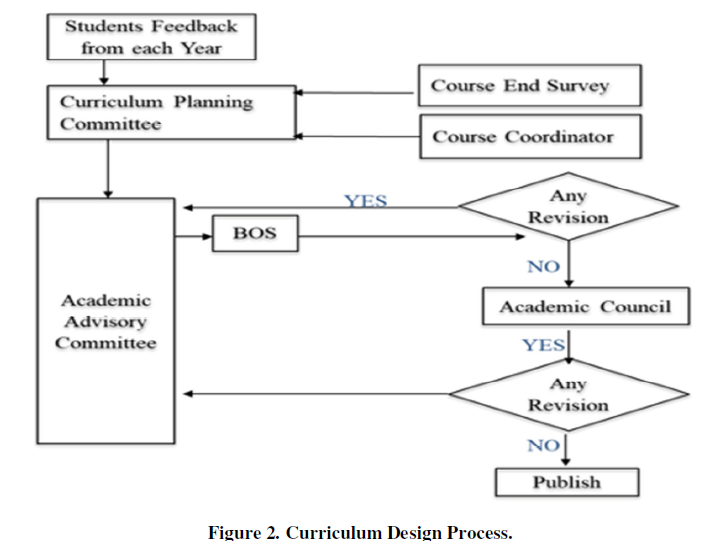

The following coordinators and committees are involved in curriculum design.
Course Coordinator: Individual faculty having experience in teaching particular course.
Academic Advisory committee: Each Program/Department to have an Academic Advisory committee to develop/revise Program Educational Objectives.
BOS: Board of studies which comprises of subject experts within and outside of R V College of engineering from academic and industrial background.
Academic Council: Each institute to have Academic Council (AC) to monitor academic regulation given by BOS.
For the core engineering courses various sources of inputs are also considered. There are few basic courses required for all the engineering programs. The basic courses are taught in the first year of the engineering program. Engineering Chemistry Course is one of the basic courses. It’s a five-credit course, having theory and lab components. Sample Course Learning Objectives of Engineering Chemistry course is given below.
- Describe the basic concepts of chemistry behind the development of futuristic materials for various applications in Engineering and technology.
- Explain the Chemistry and processes involved in development of alternate and sustainable energy sources.
- Learn to apply the knowledge of behaviour of materials that play a vital role in selection of materials and design of products in Engineering.
- Understand the importance of natural resources and aim at solutions for sustenance of life.
- Motivate to gain the knowledge of analytical techniques involved in the analysis and characterization of materials.
After successful completion of the engineering chemistry course, the learner will be able to execute the following course outcomes. Course outcomes are categorized according to Bloom’s Taxonomy level from lower level L1, L2, L3 and L4. Sample course outcomes for Engineering Chemistry course is given below.
CO1 - Explain the principles of Chemistry in Engineering. (L1)
CO2 - Applying the knowledge of Chemistry in solving societal problems related to public health, safety and environmental issues. (L2, L3)
CO3 - Identify, analyze and interpret engineering problems associated with chemistry to achieve solutions. (L3, L4)
CO4 - Develop solutions for problems associated with water, fuel, corrosion, battery, nanomaterial and polymer technologies. (L4)
The four COs are covered in both theory and practical syllabus. As Engineering Chemistry is a basic course for all engineering programs, it does not contribute to higher order skills. It helps the learner to understand the basic principles of chemistry to apply in real situations in their respective domain. Engineering graduates need to be prepared to face various challenges including work environment in different organizations and providing solutions to different types of problems.
These course outcomes are designed in such a way that they are specific, measurable, achievable, realistic and time bound. Course outcomes are focused on the results of student’s learning and not on the learning or teaching process. Learning activities are aligned with the course outcomes (Koohang, Riley, Smith & Floyd, 2010). Learning activities are designed and organized to help learners achieve the course outcomes. The Course outcomes for each course provide the anchor for course design. Assessment is directly linked to the course outcomes. Learners demonstrate their achievement of the course outcomes in the assessment activities. The course outcomes of all the courses lead to the achievement of the program outcomes. While designing/ revising a course it is important to know how this course will contribute with the other courses in the program to help learners achieve the program outcomes. Curriculum maps are very much essential while designing the curriculum. The program outcome acts as a goal for all the course curriculum design.
STEP-2:
TEACHING AND LEARNING METHODOLOGIES
Once the course outcomes identified and curriculum is designed, the next step is to design the delivery and assessment method. The delivery method is important to ensure that the student is able to acquire the required knowledge and skill (Abidin, Anuar & Shuaib, 2009). In traditional method all teaching and instructions in class room has been done in face to face interaction basis. The advancement and popularity of computers and network technologies has introduced e-learning in higher education (Sun, Tsai, Finger, Chen & Yeh, 2008). For engineering profession communication and collaboration is very much essential (Szewkis et al., 2011). In teaching methodologies, collaborative learning is an improvement over traditional learning. It engages the student in class while learning and also to acquire team work skill. Bloom’s taxonomy emphasizes creative thinking while learning to solve critical problems. Creative thinking is a thinking pattern that leads to creative result (Perkins, 1984). According to Epstein’s Generativity Theory creativity depends on four core competencies such as capturing novelty, challenging established thinking, broadening one’s knowledge and surrounding oneself with new stimuli environment. Some of the popular teaching methodologies are traditional class room teaching, flipped class room teaching and blended classroom teaching.
TRADITIONAL CLASS ROOM TEAHING
Traditional class room teaching it is mostly teacher centric. The teacher comes to the class writes on the board and explains the content and students keep themselves busy in writing and understanding. Some of the students who can’t understand the content they simply copy down the content from the board, lose their interest and feels disconnected with the course. As most of the time in the class is taken by the teacher in explaining the concept the student has less opportunity to interact with the teacher.
FLIPPED CLASS ROOM TEACHING
Flipped class room teaching is one the innovation of modern education, which is learner centric (Yelamarthi & Drake, 2015; Mason, Shuman & Cook, 2013).
The word “FLIP” meaning.
F – Flexible Environment (Allow varieties of learning modes. Group/individual activity, flexibility in time, usage of different tools etc.)
L – Learning Culture (Shift from Teacher centered (traditional) to Learner centered)
I – Intentional Content (In order to have maximum utilization of class room educator think and prepare flipped learning model to teach and to explore by the student)
P – Professional Educator (Role of Professional Educator)
Role of Professional Educator is even more important and demanding in a Flipped Classroom than in a traditional one. Mazur’s research work shows that in flipped class instructor’s role is coaching rather than lecturing and student’s critical thinking capabilities also improved (Crouch & Mazur, 2001; Mazur, 1997). In flipped class room teaching students are asked to read contents from textbook and other resource materials in prior coming to the class. Class time is used on solving problems, conducting class activities, and seeking help from the instructors to clarify the concept (Erasmus & Dyk, 1999; Cold, 2013).
BLENDED CLASS ROOM TEACHING
It is possible to design classes that are combination of both flipped and traditional. Such type of new method of teaching is popularly known as blended learning. Instructor plays very important role in the implementation and success of blended learning. The role of instructor changes from lecturer to facilitator in the blended and flipped learning environment. Instructor motivates and guides students in the new learner centric environment (Ahmed, 2010). Some of the blended best practices used for Engineering Chemistry are discussed here.
Digital Notes: Students are provided with detailed digitized course content. The course contents are prepared by compiling the contents from various text books and other materials. The instructor also gives some additional information beyond the syllabus to help the learner for further studies, if interested. These documents can be downloaded and used offline.
Video Notes & Tutorial: Some of the critical concepts are explained by the instructor are recorded and made available to students. The aim of video notes is if the student is not able to understand in the class or absent in the class, then they have the opportunity to listen again to understand it. For the same concept selected YouTube videos are also added, so that student can get the concept by watching one of the video. For Engineering Chemistry practical video contents are about: how to prepare a data sheet, how to write an experiment record or how to perform an experiment. These are very useful for the students while preparing themselves to attend the laboratory sessions. If the students have any questions then they need not come to the instructor for clarification which saves time.
Question Paper: Module question papers for CIE (Test & Quiz) and SEE (Semester exams) are also available for the students to get familiar with the question paper pattern. Question bank is prepared in order to practice more problem solving and to get an idea about the questions which might be framed.
PowerPoint Presentations: The PowerPoint presentations which instructors use to explain in the class are also made available to the students to increase their understanding on the concept. While listening to the instructor’s explanation it’s difficult to draw or note down the contents displayed on the presentation. When they go through the presentation, they can recollect what explanation was given in the class.
Games: Jeopardylabs.com in which the instructor has designed interesting games for each chapter of the course. The purpose of it is to engage the students in games, while learning is taking place. It develops high level critical thinking capabilities, as in the game answers are displayed and students are asked to formulate the question. This is very different than the traditional way, where the instructor always asks the question. It also helps foster collaborative and communication skill.
Wikispaces/Wix: Engineeringchemistryrvce.wikispaces.com
It is a learning management system (LMS), where the students can obtain all the information and documents related engineering chemistry course. Students register for assignment or seminar through this portal. Options are given for the students to respond to the course end survey and give their feedback.
Quiklrn: Taking the advantage of smart phone usage, RV College introduced an app Quiklrn. It has got lots of features to customize the study material according to learner’s convenience. This App is developed by Quiklrn Private Limited (Quiklrn Private Limited, Version 1.0.8, 2017).
Text Books: The library in the campus contains many engineering chemistry text books and reference books also. Students are allowed to borrow the text books to read or prepare their own study materials along with the other e-resources available.
Practical: Students are provided with lab manual, instruction and demonstration to perform experiments. With the theoretical knowledge the practical experience increases the depth of understanding. Some of the experiential learning experiments are included to increase their creative and experimental skill.
Self-Study Component: For a given a topic, student work in a team to understand the principle, methodology and application. Findings are explained by presentations. This type of activity enables students’ skills in communication, team work, research and working in cross functional areas.
Exposure to Research Facility: To ignite an interest for higher studies and research, the instructor organizes visits to the R & D facility available in the campus. Students get chances to see the R & D facility, instruments available, interact with the domain experts and exposure to the concept of interdisciplinary research.
Online Courses: Many of the accreditation bodies/organizations have introduced online course in their accreditation criteria. Students are encouraged to take online courses related to the course.
Remedial Class: Specially designed for the poor performance students.
These are some of the methods adopted to overcome the learning challenges. Even though so many ways are implemented, the greatest challenge for the instructor is to adopt the new technology and prepare the study material for the learners.
STEP-3:
ASSESSMENT
Assessment process is critical to measure the learning outcomes. Two types of assessments are done such as formative assessment (Continuous Internal Evaluation - CIE) and summative assessment (Semester End Evaluation - SEE). Formative assessment is done during the instructional or teaching process to gather information and also to improve teaching and learning in real time. The flow chart for assessment process is given in Figure 3.
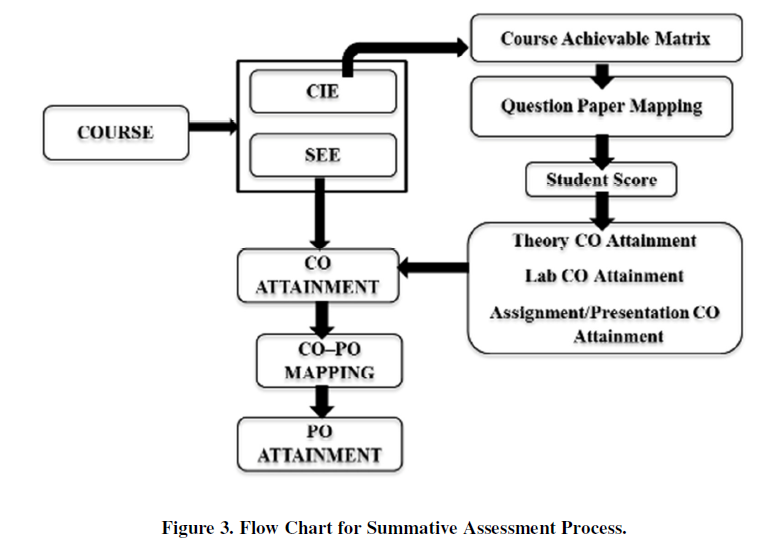

The final grading of the student is out of 300 marks. Out of which, Continuous Internal Evaluation (CIE) is of 150 marks and Semester End Evaluation (SEE) is also of 150 marks. The splitting of marks for CIE and SEE as follows:
CIE = Theory (90 marks) + Assignment (10 marks) + Lab (50 marks)
SEE = Theory (100 marks) + Lab (50 marks)
For CIE, the question paper setting is done through Achievable Matrix.
Achievable Matrix is a matrix which helps the marks distribution in the question paper w.r.t course outcomes. Beginning of the semester or academic session the achievable matrix is prepared and followed throughout the semester.
Construction of Achievable Matrix:
There are five units (U1 to U5) in the Engineering Chemistry syllabus.
Step A - In CIE the test and quiz is conducted out of 90 marks. All the units are given equal weightage so each unit is given a total of 18 marks in the last column.
Step B - The total marks of each unit are divided into four COs.
Step C - The row labeled as “Total” indicates the total marks allocated to each COs out of 90.
Step D - The percentage of marks allocated for each COs,
The achievable matrix prepared for the theory component of engineering chemistry course is given in Table 1.
Table 1. Achievable Matrix – Theory.
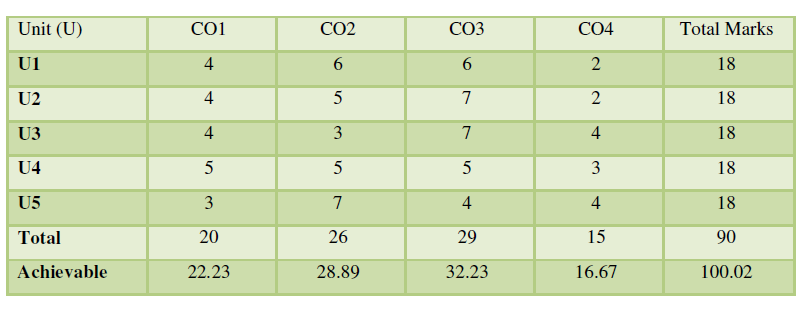

The target percentage of marks for each CO is obtained from Table 1. In CIE the total marks for theory is 90, out of which quiz is for 30 marks and test is for 60 marks. Hence quiz to test ratio is 1:2, based on this each CO percentage is split into quiz and test. In CIE there are three Quiz of equal weightages and two Test of equal weightage. The CO percentage for each quiz is calculated by dividing the Quiz percentage by three and given as Q1=Q2=Q3, similarly CO percentage for test is calculated by dividing the Test percentage by two. The CO percentage for test and quiz is given in Table 2.

Actual Marks distribution for Quiz and Test is done by taking the CO% of marks obtained in Table 2. Each Quiz is conducted out of 10 marks. As per the Table II CO percentage distribution the actual marks distribution for each CO out of 10 is calculated. Similarly, actual CO marks distribution for Test is calculated out of 50. The final test mark obtained by the student out of 50 is reduced to out of 30, for CIE calculation. The percentage of marks, actual marks distribution and portion distribution for each Quiz and Test is given in Table 3.

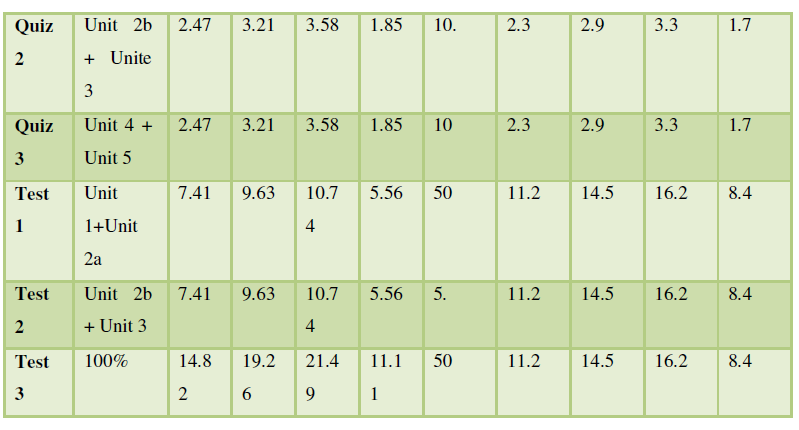


As per Table 3, the marks distribution is done in quiz and test by rounding up thenumber. The actual marks distribution in the question paper is given in Table 4.

It is necessary to follow the marks distribution obtained from acheivable matrix while setting the question paper. This will help to measure the learning outcomes of the student. It also leads to completion of the syllabus on time and sets accountability for the instuctor as well as for the learner.
STEP 4:
COURSE OUTCOME ATTAINMENT (COA) & CO–PO MAPPING
CIE CO Attainment
CIE CO attainment is calculated after the test/quiz is conducted and valuation is done. Following are the steps required to calculated CO attainment for theory.
Step 1: Construction of CO-question paper mapping matrix. In this matrix the matrix elements are 1 if the question belongs to that particular CO. If the question corresponds to two COs then the matrix element is 0.5 (if equal weightage) or else the matrix element is determined by the weightage of particular CO. If the question doesn’t belong to a particular CO then matrix element is zero.
Step 2: Detailed marks entry in excel sheet for each student is done.
Step 3: CO attainment is calculated for each student for each quiz and test
separately.
Average of all three quiz and two tests gives the final theory CO attainment of the student.
Step 4: Similarly, CO attainment for lab component and assignment is calculated using rubrics. Achievable matrix for lab component and assignment is also prepared similar to theory component achievable matrix.
Step 5: Final CO attainment for a student is calculated by taking the average of attainment obtained in theory, lab and assignment component.
Step 6: In a particular branch the average of the entire student’s CO attainment gives the CO attainment of that particular branch. Similarly, CO attainment of a particular course in a semester is obtained from the CO attainment of all the branches included in that semester.
The evaluation of experiments, seminar and assignment is done using rubrics. The rubrics components used for evaluations are given below in Table 5.
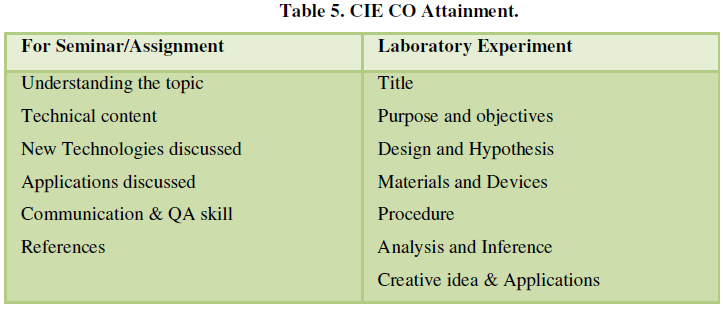

Rubrics are used for evaluation, where direct evaluation is not possible. Rubrics components are mapped to different components of experiment and presentation to assign marks. For 2016-17 odd semester the Engineering Chemistry CO Attainment obtained for different branches is given below in Table 6.




An automated excel sheet is prepared to calculate Total CIE marks CO attainment and CO-PO mapping of Engineering Chemistry course. It also gives the grade status to encourage student for the SEE preparation. This excel sheet is customized for some of few other courses.
SEE CO Attainment
For SEE the CO attainment is done by the examination section because of confidentiality reason. The SEE CO attainment may not be as accurate as the CIE attainment for two reasons.
- In the question paper the marks distribution is not as per Achievable matrix.
- Sometimes exact mapping of the questions to COs are difficult.
Course end survey CO Attainment
Students respond online to course end survey questioner. In the questioner the questions are mapped to different COs. CO attainment is calculated using the same formula used for theory CO attainment calculation. The sample questioner used is given in Table 7.
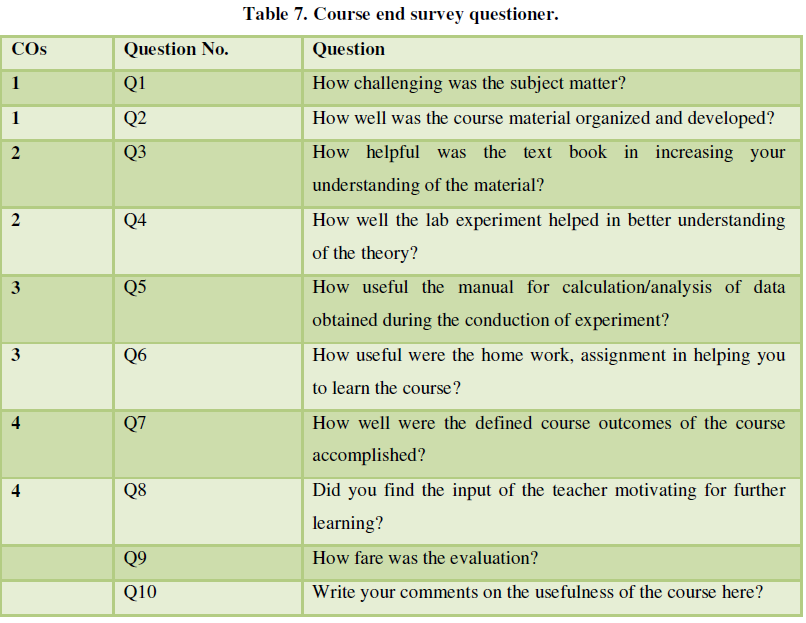

The course end survey analysis is shown in Table 8 and Figure 4.


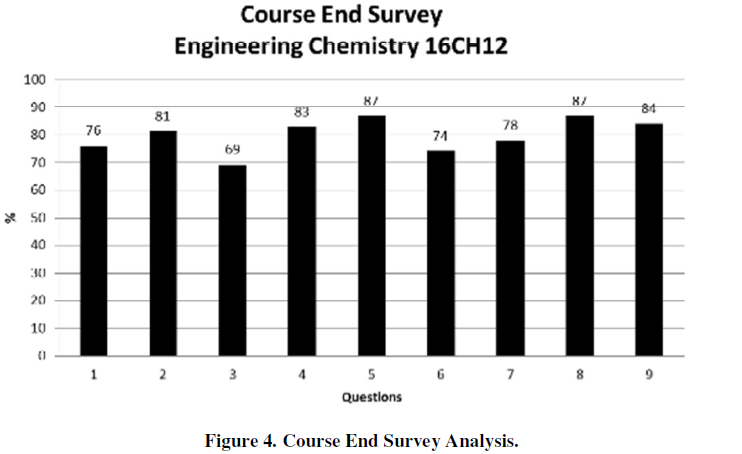



The final CO attainment is calculated from the attainments obtained from CIE, SEE and Course End Survey.
A = CIE CO Attainment (80%) + SEE CO Attainment (20%)
Final Attainment is calculated as: A (90%) + Course End Survey Attainment (10%)
CO-PO Mapping
For Engineering Chemistry course mapping of the four COs to Program Outcomes (POs) is given in Table 9.


Using Table 5 and Table 7, the contribution of COs to each PO is calculated and given in Table 10.


Contribution of COs to each PO is obtained by taking average of all the branches to that particular PO. In the beginning the target must be set for the COs contribution to each PO. Action plan for the next academic session is decided by comparing the calculated CO contribution to PO with the target value in order to enhance the learning outcomes and quality of teaching - learning process.
CONCLUSION
To improve the quality of education and to get recognition across the globe, it is essential to get accreditation from different accreditation agencies. Each accreditation agency has its own set of criteria to assess the teaching and learning. The quality of teaching can be judged by measuring the learning outcomes. Following the method described in this paper it is observed that there is gradual enhancement of learning outcomes. It is also observed that the learning outcomes are better in blended mode of teaching compared to traditional method of teaching. Student’s involvement is more in the class room to extract more information from the instructor. Instructor needs to decide how to implement the blended mode of teaching depending on the understanding level of student. Even though it is time consuming on the instructor’s part to prepare the study materials and to keep pace with the advanced technology but the investment is worth.
ACKNOWLEDGMENT
Swarna M Patra thanks Dr Raviraj A Kusanur, HOD Chemistry and all the faculty members of Department of Chemistry for their encouragements, suggestions, validation and implementation of the software.
Abidin, I.Z., Anuar, A. & Shuaib, N.H. (2009). Assessing The Attainment Of Course Outcomes Co For An Engineering Course. Proceedings of the 2nd International Conference of Teaching and Learning, INTI University College, Malaysia, ICTL.
Ahmed, H.M.S. (2010). Hybrid e-learning acceptance model: Learner perceptions. Decision Sciences Journal of Innovative Education 8(2), 313-346.
Bhattacharjee, B. & Deb, K. (2016). Role of ICT in 21st Century’s Teacher Education, International Journal of Education and Information Studies 6(1), 1-6.
Basril, H., Man, A.B., Badaruzzaman, C. & Nor, M.J.M. (2004). Malaysia And The Washington Accord: What it Takes For Full Membership. International Journal of Engineering and Technology 1(1), 64-73.
Bellis, I. (2000). Delivering HRD in the new millennium-are we taking it there or being taken? SANDF Bulletin for Educational technology 23,13-24.
Crosthwaite, C., Cameron, I., Lant, P. & Litster, J. (2006). Balancing curriculum processes and content in a project centred curriculum in pursuit of graduate attributes. Chemical Engineering Research and Design 84, 619-628.
Crouch, C H. & Mazur, E. (2001). Peer instruction: Ten years of experience and results. American Journal of Physics 69, 970-977.
Cold, S.J (2013). Partially flipped: Experiences using POGIL. Proceedings of the 14th Annual ACM SIGITE Conference on Information Ttechnology Education, 133-134.
Cabrera, I., Villalon, J. & Chavez, J. (2017). Blending Communities and Team-Based Learning in a Programming Course. IEEE Transactions on Education 60(4).
Erasmus, E.J. & Van, D. (1999). Training Management in South Africa. 2nd ed., Halfway House: International Thomson.
Gomes, V.G. (2006). Chemical engineering curriculum renewal. Education for Chemical Engineers 1, 116-125.
Jaafar, M.S., Nordin, N.K., Wagiran, R., Aziz, A., Noor, M.J.M.M., et al. (2008). Assessment strategy for an outcome based education. International Conference on Engineering Education.
Janz, K., Graetz, K., & Kjorlien, C. (2012). Building collaborative technology learning environments,” in Proceedings of 40th Annual ACM SIGUCCS Conference User Service, 121-126.
Kisa, M.T. & Stein, M.K. (2015). Learning to see teaching in new ways: A foundation for maintaining cognitive demand. American Educational Research Journal 52(1), 105-136.
Kolb, D.A. (1984). Experiential learning: Experience as the source of learning development. 1, Prentice Hall Englewood Cliffs, NJ.
Mason, G.S., Shuman, T.R. & Cook, K.E. (2013). Comparing the effectiveness of an inverted classroom to a traditional classroom in an upper-division engineering course. IEEE Transactions on Education 56(4), 430-435.
Mazur, E. (1997). Peer instruction: Getting students to think in class. American Institute of Physics,pp: 981-988.
Perkins, D.N. (1984). Creativity by design. Educational Leadership 42, 18-25.
Reichgelt, H., Zhang, A., & Price, B. (2002). Designing an information technology curriculum: The Georgia Southern university experience. Journal of Information Technology Education 1, 213-221.
Riley, L.K., Smith, T. & Floyd, K. (2010). Design of an information technology undergraduate program to produce IT versatility. Journal of Information Technology Education 9, 99-113.
Rutherfoord, R.H. & Rutherfoord, J.K. (2013). Flipping the classroom-Is it for you? Proceedings of 14th Annual ACM SIGITE Conference Information Technology Education, pp: 19-22.
Sun, P.C., Tsai, R.J., Finger, G., Chen, Y.Y. & Yeh, D. (2008). What drives a successful e-Learning? An empirical investigation of the critical factors influencing learner satisfaction. Computers and Education 50, 1183-1202.
Szewkis, E. (2011). Collaboration within large groups in the classroom. International Journal of Computer-Supported Collaborative Learning 6(4), 561-575.
Spady, W. (1994). Outcomes based education: Critical issues and answers, American association of school administration. Arlington, Virginia.
Schwalbe, K.A. (1996). A study of the relationship between investments in information technology and institutional outcomes in higher education. Ph.D. dissertation, Dept. Educ., Univ. of Minnesota, Minneapolis, MN, USA.
Shulman, L.S. (1999). “Taking Learning Seriously”, Faculty Teaching Excellence Program, Office of Academic Affairs, University of Colorado at Boulder, 63.
Silverman, L.K. (1988). Learning and teaching styles in engineering education. Engineering Education 78(7), 674-681.
Szafir, D. & Mutlu, B. (2013). ARTFuL: Adaptive review technology for flipped learning. Proceedings of SIGCHI Conference Human Factors Computer System, 1001-1010.
Wahab, H.F.A., Ayob, A., Zaki, W., Hussain, H., Hussain, A., & Mokri, S.S. (2011). Program outcomes measurement and assessment processes. Procedia Social and Behavioral Sciences 18, 49-55.
Walkington, J. (2002). A process for curriculum change in engineering education. European Journal of Engineering Education 27, 133-148.
Yelamarthi, K. & Drake, E. (2015). A flipped first-year digital circuits course for engineering and technology students. IEEE Transactions on Education 58(3), 179-186.





